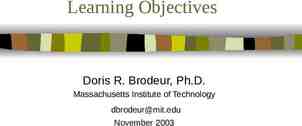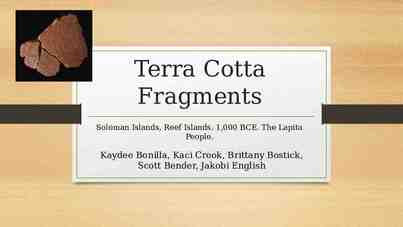Writing Literature Reviews and Research Proposals Galvan, Jose L.
41 Slides434.50 KB
Writing Literature Reviews and Research Proposals Galvan, Jose L. 1999. Writing literature reviews: A guide for students of the social and behavioral sciences. Los Angeles, CA: Pyrczak Publishing. 1 1
Information Sources Primary (empirical) sources***** – original; empirical; first published account – details on methodology, findings, and discussion – systematic observation (carefully planned) Secondary sources – found in books, magazines, newspapers – global descriptions of findings 2 2
3 Potential Problems with Empirical Research Sampling – unrepresentativeness – sampling bias Measurement – flawed instrumentation (surveys, interviews, observation, experimentation) – multiple measures -- consistent results? Problem identification – researchers studying same problem might examine 3 different specific (narrow) areas of the problem 3
Other Sources Theoretical articles – theory built on existing empirical work – pieces of theory can be tested empirically – follow up on leads in bibliography Literature review articles – new and fresh insights that advance knowledge resolve conflicts in articles that contradict each other identify new ways to interpret results lay out a path for future research/generate propositions Antecdotal Reports (do4 NOT use these) 4
Writing Process Planning – defining a topic and selecting literature Organizing – analyzing, synthesizing, and evaluating review articles Drafting – writing a first draft of the review Editing – checking draft for completeness, cohesion, correctness Redrafting 5 5
Questions to Ask in Evaluating an Empirical Article Are there obvious sampling problems? Are there obvious measurement problems? Is the problem narrow enough? Too narrow? Are there any other flaws in the paper? Does the research make an important contribution to advancing knowledge? 6 6
Questions to Ask in Evaluating Review Articles Have the reviewers clearly identified the topic of review? Have the reviewers indicated its delimitations (time period, aspects of the problem, etc)? Have the reviewers written a cohesive essay that guides you through the lit from topic to topic? Have the reviewers interpreted the literature (as opposed to summarizing)? Did the reviewers make an important contribution? 7 7
Writing for Specific Purposes Term paper for class – Plan carefully -- use a timeline. Don’t wait til the last minute to start. Pace yourself. – – – – Stage 1: Prelim library search and selection of topic Stage 2: Reading list and prelim paper outline Stage 3: First draft of paper Stage 4: Revised final draft of paper Ask questions of your instructor -- understand expectatns Keep your topic narrow; choose a well-defined topic Use textbook subheadings or articles to help you choose 8 8 Get feedback on drafts (if possible)
Writing for Specific Purposes Journal Article – introduction to topic, statement of purpose of empirical research, and lit review – establishes scientific context for study – very straightforward, short, focused. – Provide rationale and background for specific and often very narrow research projects – should reflect current state of research; articles included should be the most recent 9 9
Identifying Literature Search an appropriate database – can start with general topic – better to start with more specific topic, but can narrow down a general topic after seeing list of articles Shorten list to a manageable size – which articles pertain to your major field of study? – reclassify articles in the list – is the journal respected in your field? 10 10
Additional Steps to Get Started Write the first draft of your topic sentence – name the area you will investigate, in general – after examining more focused list of articles Pick on-line databases that are appropriate for your topic As you search databases for articles and narrow your search, redefine your topic more narrowly. Start with the most current and work backwards 11 11
Steps to Get Started Use most recent applicable article(s) as sources for more articles. – Compare bibliographies to your previous list and make strategic decisions about which to include. Keep in mind: list should represent the extent of knowledge on the topic list should provide a proper context for your investigation Search for theoretical articles in databases and bibliographies of articles Search for review articles, proposals, meta-analyses 12 12 Identify landmark or classic studies
Guidelines for Analyzing Literature Analyze chosen articles before you start writing 1. Scan articles to get an overview of each – first few paragraphs, paragraph before Method, major and minor subheadings, hypotheses, purposes, scan text (but don’t get caught in details), first para of Discussion – keep an eye on big picture by pre-reading – take notes on first page about overall purpose/findings 2. Based on #1, group articles by category – by topic and subtopic, then chronologically 13 13
Guidelines for Analyzing Literature 3. Organize yourself before reading – computer, pack of note cards for comments, selfadhesive flags to mark important places 4. Use a consistent format in notes – begin reading and making notes of important points on cards – start a system of note-taking and use system consistently – what is notable about the article? Landmark/flaws/experimental/qualitative? 14 – Use several cards per article 14
Guidelines for Analyzing Literature 5. Note explicit definitions of key terms – note differences between/among researchers 6. Note methodological strengths and weaknesses – e.g., triangulation of methods, sample sizes, generalizability. – does one article improve upon another bc of method? – does innovative methodology seem appropriate? – Is there enough evidence to support conclusions? – critique groups of studies together, esp if similar flaws 15 15 – note patterns of weaknesses across studies
Guidelines for Analyzing Literature 7. Distinguish between assertion and evidence – understand empirical findings from data collected – v. author’s opinion 8. Identify major trends or patterns in studies – if conflicting results, try to explain them – can make a generalization based on majority of articles or those with strong methodology. – Describe these generalizations carefully. 9. Identify gaps in literature and discuss why 16 16
Guidelines for Analyzing Literature 10. Identify relationships among studies – when write, discuss them together 11. Note how each article relates to your topic – keep your specific topic in mind all the time and make sure your articles address it. If not, do not include 12. Evaluate your list for currency and coverage – start with most recent 5 years and include others if necessary. 17 17
Guidelines for Analyzing Methodology 1. Qualitative or quantitative? (makes notes) – Quantitative: results presented as stats and numbers explicitly stated hypotheses large (100-1500), random sample from particular population objectively scored instruments inferential statistics -- make inferences about pop from sample – Qualitative: results presented as narrative general, nonspecific problem, with no rigid, specific purposes small, purposive (not random) sample measure with unstructured instruments (interviews) 18 18 results in words with emphasis on understanding sample
Guidelines for Analyzing Methodology 2. Experimental or nonexperimental? – Experimental: treatments administered to participants for purposes of study effects of treatments assessed almost all are quantitative – Nonexperimental: participants’ traits measured without attempting to change them quantitative or qualitative do not use the term ‘experiment’ to describe, use ‘study,’ ‘investigation,’ etc. 19 19
Guidelines for Analyzing Methodology 3. Participants randomly assigned to conditions? – Guarantees no bias in assignment. – More weight given to true experiments (with RA). 4. Cause/effect relationships asserted in nonexperiments? 5. How were major variables measured? – Reliability and validity; appropriateness of measures – triangulation and strength of conclusions – discrepancies in results and patterns in method 20 20
Guidelines for Analyzing Methodology 6. Characteristics of participants/samples? – Make notes on demographics. – Could demographics have played a role in results? (no way you can say for sure, but might raise question 7. How large is difference?. not just significance – statistically significant -- greater than chance, not necessarily big. 8. Major flaws? (do not dissect each article) – Safe to assume that all empirical studies have them. 21 21 – Degrees of evidence
Synthesizing Literature 1. Decide purpose and voice – Purpose: term paper, dissertation/thesis, journal article? – Voice: formal, de-emphasize self, avoid first person (usually) 2. Consider how to reassemble your notes – NOT a series of annotations of research studies – describe the forest (not the trees) from a unique perspective using the trees you found – how do the pieces relate to22 each other? 22
Synthesizing Literature 3. Create a topic outline that traces your argument – establish for the reader the line of argumentation (thesis) – develop a traceable narrative that demonstrates the loa is worthwhile and justified (writer formed judgments about topic based on analysis and synthesis of lit) – TO is roadmap of argument. Starts with assertion, then introduction, systematic review of relevant literature, and ends with conclusion that relates back to original assertion 4. Reorganize notes according to path of argument 23 – code cards according to TO; write cites on TO 23
Synthesizing Literature 5. Within each topic heading, note relationships among studies – can subgroups be created? Add detail to your outline – consider consistency of results from study to study if discrepant, provide relevant info about research, trying to identify possible explanations for the differences 6. Within each topic heading, note obvious gaps – discuss in manuscript 24 24
Synthesizing Literature 7. How do individual studies advance theory? – Often researchers will discuss this in their studies -- use their expertise. 8. Plan to summarize periodically and again near end of the review – especially with long, difficult, or complex topics – help reader understand direction the author is taking – begin last section with brief summary of main points 25 25
Synthesizing Literature 9. Plan to present conclusions and implications – conclusion: statement about state of knowledge using degrees of evidence. “it seems safe to conclude that.” “one conclusion might be.” – if weight of evidence does not favor one conclusion over the other, say so – implication: statement of what people or organizations should do in light of existing research. What actions (interventions) seem promising based on review you are now an expert and can offer conclusions and 26 26 implications.
Synthesizing Literature 10. Plan to suggest directions for future research – make specific (relevant) suggestions about gaps can be populations (understudied groups), methodologies, etc 11. Flesh out TO with details from analysis – final step before write first draft – include enough detail to write clearly about studies strengths/weaknesses, gaps, relationships, major trends – TO will be several pages long – studies may appear in several places on TO 27 27
Writing First Draft 1. Identify broad problem area; avoid global statmts – start broad in your topic area and work toward specific 2. Indicate why certain studies are important 3. If commenting on timeliness, be specific 4. If citing a classic or landmark, say so 5. If landmark was replicated, say so and state result 6. Discuss other lit reviews on topic 7. Refer reader to other reviews on related topics 28 8. Justify comments such28as “no studies were found”
Writing First Draft 9. Avoid long lists of nonspecific references 10. If results of studies are inconsistent or widely varying, cite them separately 11. Cite all relevant references in review section of a thesis/dissertation or journal article 12. Emphasize the need for your study in your lit review section or chapter – closes gap in lit, tests important aspect of current theory, replicates important study, retests hypothesis using new or improved method, resolves conflicts in lit, etc 29 29
Develop a Coherent Essay Remember: this is not an annotated bibliography (a series of connected article summaries). Review should have a clearly stated argument, developed in such a way that all elements work together to communicate a well-reasoned account of argument 1. Describe review outline for reader – introductory paragraphs should include roadmap of where you are going in paper 2. Near beginning, state what will and won’t be 30 30 covered
Develop a Coherent Essay 3. Specify your point of view early – serves as thesis statement -- the assertion or proposition that is supported in remainder of report – can incorporate it into description of path of argument 4. Aim for a clear and cohesive essay; avoid annotations – organize research to make a point – translate TO into prose account that integrates important details of research lit into an essay that communicates a 31 31 point of view
Develop a Coherent Essay 5. Use subheadings, esp in long reviews – use TO to place strategically to help advance argument 6. Use transitions to help trace your argument – e.g., first, second, third 7. Consider a table for comparing studies – main characteristics of related studies – still must discuss them in narrative 8. If topic crosses disciplines, review separately – e.g., diabetes in teenage girls: nutrition, medical, psych 32 32
Develop a Coherent Essay 9. Write a conclusion for the end of the review – depends on reason for writing review – stand alone: make clear how material in body supports assertion or proposition presented – thesis/diss/journal article presenting original research: not labeled as conclusion. Lit review leads to research questions/hypotheses that will be addressed. – If paper is long and complex, briefly summarize 10. Check flow of argument for coherence (does manuscript hold together33as unified document) 33
Style, Mechanics, Language 1. Compare draft with TO – ensure you have fleshed out the path of the argument 2. Check structure of your review for parallelism – balance in arguments: for/against; strengths/weaknesses 3. Avoid overusing direct quotations – quotations should not be isolated from surrounding prose 4. Check style manual for correct use of citations 5. Avoid using synonyms for recurring words – allow the reader to compare across studies and internalize 34 34 information quickly
Style, Mechanics, Language 6. Spell out acronyms when first use and avoid using too many 7. Avoid contractions 8. Coined terms should be quoted 9. Avoid slang expressions, colloquialisms, idioms 10. Use Latin abbreviations in parenthetics. Use English elsewhere – (e.g., ); (cf. .) or .for example, 35 35
Style, Mechanics, Language 11. Check draft for common writing conventions – complete sentences avoid first person – avoid sexist language strive for clarity – use active voice 0-9 spell out, 10 write – spell out number when first word in sentence. 12. Write a concise and descriptive title – identify field of study and point of view – help reader adopt frame of reference – avoid “cute” titles 36 – keep it short 36
Style, Mechanics, Language 13. Strive for user-friendly draft (for feedback) – – – – spell-check, proofread, edit number pages double-space use 1” margins staple or binder clip identify yourself font should be readable avoid “cute” touches 14. Avoid plagiarism at all costs – see University rules about this 15. Get help if you need it – hire proofreaders 37 – go to writing center on campus 37
Incorporating Feedback.Refining Put the ms aside for a time to create some distance Remember that writing is an ongoing process of negotiation between writer and audience Approach draft from viewpoint of audience member Get feedback from anyone who will read your paper DO NOT BE PERSONALLY OFFENDED BY SOMEONE’S CRITICAL EVALUATION of your work!!!!! 38 38
Incorporating Feedback.Refining 1. The reader is always right – if the reader did not understand a point, rewrite it. What needs to be clarified? What specifically is the trouble? 2. Expect your instructor to comment on content – do not make it difficult for instructor to read/understand get the style/grammar/language in order before handing it over 3. Concentrate on comments about ideas – did ideas come across as you intended? 4. Reconcile contradictory feedback 39 39 – seek clarification from both and negotiate a resolution
Incorporating Feedback.Refining 5. Reconcile comments about style with a style manual 6. Allow plenty of time for feedback and redrafting process – at least one or two drafts!! 40 40
Writing Literature Reviews By Jose Galvan, 1999, Pyrczak Publishing, LA, CA Excellent book with great examples Contains a comprehensive self-editing checklist for refining the final draft at end. Contains 3 excellent literature reviews for evaluation and analysis I *highly recommend* purchasing this book 41 41














































